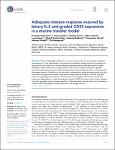Adequate immune response ensured by binary IL-2 and graded CD25 expression in a murine transfer model
Fuhrmann, Franziska
Lischke, Timo
Gross, Fridolin
Scheel, Tobias
Bauer, Laura
Kalim, Khalid Wasim
Radbruch, Andreas
Herzel, Hanspeter
Hutloff, Andreas
Baumgrass, Ria
The IL-2/IL-2Ralpha (CD25) axis is of central importance for the interplay of effector and regulatory T cells. Nevertheless, the question how different antigen loads are translated into appropriate IL-2 production to ensure adequate responses against pathogens remains largely unexplored. Here we find that at single cell level, IL-2 is binary (digital) and CD25 is graded expressed whereas at population level both parameters show graded expression correlating with the antigen amount. Combining in vivo data with a mathematical model we demonstrate that only this binary IL-2 expression ensures a wide linear antigen response range for Teff and Treg cells under real spatiotemporal conditions. Furthermore, at low antigen concentrations binary IL-2 expression safeguards by its spatial distribution selective STAT5 activation only of closely adjacent Treg cells regardless of their antigen specificity. These data show that the mode of IL-2 secretion is critical to tailor the adaptive immune response to the antigen amount.
No license information

